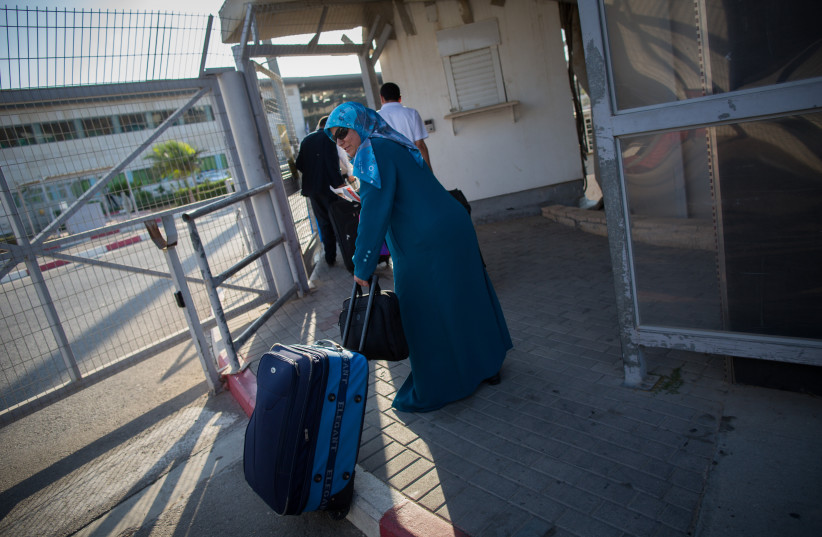Israel will increase the number of labor permits for Palestinians in the Gaza Strip by an additional 2,000 for a total of 14,000, Israel’s Coordinator for Government Activities in the Territories announced on Thursday.
The move comes as Israel and Hamas mark a year since Operation Guardian of the Walls last May. The decision by COGAT, made after a security assessment, comes in parallel to the work to implement the decision made by Defense Minister Benny Gantz to allow in a total of 20,000 Gazan workers.
“The permits will be granted following the criteria, and subject to a security evaluation.”
COGAT
Following the 11-day war last year, Israeli officials pledged to ease some restrictions on Gaza’s civilian population in exchange for quiet in the South.
“The permits will be granted following the criteria, and subject to a security evaluation,” said COGAT. “All the latest civil measures regarding the Gaza Strip are dependent on the continued maintenance of stable security over time, and their expansion will be considered in light of the situation as evaluated.”

The announcement comes as the IDF presented the lowest figure of rocket launches in about a decade and a half, with only 11 rockets fired from the blockaded coastal enclave in the year since Guardian of the Walls.
The numbers prove it
Though the conflict has been widely criticized, the IDF’s Southern Command has lauded the operation as the reason for the significant decrease in rocket fire toward the Israeli home front in the past year.
The military believes that the substantial beating Hamas took, especially to its military wing, is why the terrorist group has so far chosen to avoid further rounds of conflict. It’s believed that the damage done to the Gaza Strip was significant – $92 million in destroyed residential buildings, and another $70m. in other destroyed infrastructure.
According to figures released by the military, in the year following Operation Cast Lead in 2008, 297 rockets were fired. Following the 2012 war known as Operation Pillar of Defense, Israel was hit by 14 rockets. And in 2014 following Operation Protective Edge, 57 were fired. Following Guardian of the Walls, 11 rockets were fired by terrorist groups in the Strip.
“The impact of Operation Guardian of the Walls, as well as the steps that were taken after, are still felt in the Gaza Strip,” said Gaza Division Commander Brig.-Gen. Nimrod Aloni, who added that nevertheless, “tensions are high and our vigilance continues.”
Last week, Prime Minister Naftali Bennett said the past year had been the quietest for the South since the 2005 Gaza Disengagement.
“We improved the security and lives of the residents of the South and brought back deterrence,” he told the Knesset Foreign Affairs and Defense Committee. “This is a great achievement of this government.”
Operation Guardian of the Walls
DURING THE conflict last May, Hamas and Palestinian Islamic Jihad fired more than 4,000 rockets and mortars toward Israel.
The military claims to have thwarted the majority of offensive operations attempted by the terrorist groups, including efforts to abduct soldiers. The IDF also destroyed 12 cross-border attack tunnels that were 10-20 meters (33-66 feet) deep (including one between Kibbutz Kissufim and Ein Hashlosha), 100 anti-tank positions, and 60 high-quality targets including headquarters belonging to the group.
“During the 11 days of Operation Wall Guard, we were able to disrupt and suppress almost all of the terror organizations’ offensive attacks by changing the defense equation as it was,” said Aloni. “We did not wait for the terror operatives to come to the border and then fight them, but we hunted them down every time they raised their heads and tried to harm our citizens and our forces.”
“We did not wait for the terror operatives to come to the border and then fight them, but we hunted them down every time they raised their heads and tried to harm our citizens and our forces.“
Gaza Division Commander Brig.-Gen. Nimrod Aloni
A total of 450 targets were struck by the IDF, including 60 that were destroyed by precision missiles fired by commando units. In addition, 346 tank shells were fired toward targets.
The military believes that Hamas has learned the lessons from the war. In the next round of fighting, it thinks the group will attempt to launch a surprise attack on land by sending fighters through tunnels to abduct troops, or carry out an attack using anti-tank guided missiles against troops rather than launch missiles.
The Gaza Division’s new defensive concept is based on several layers of defense. These include smart defensive deployment of troops, sensors, tanks and other armored vehicles with active defense systems in Israeli territory in order to address various threats that emanate from the Strip. The goal is to deprive terrorist groups of the ability to carry out attacks against IDF forces.
The combination of the old and new 30-foot fence along the Gaza border, a new security road with warning sensors, the underground barrier, and the use of drones and other unmanned aircraft allows troops to close the circle on threats quickly and trap possible infiltrators in the area.
Gazans regularly attempt to infiltrate Israel by land and sea. Most of those apprehended are transferred back to Hamas. The military says the new technology along the fence has resulted in no infiltrations of which the army was not notified in the past four years.
“The new operational concept has completely changed the conduct of IDF forces in the barrier area,” according to Aloni, and that the IDF “will take advantage of it and reduce the enemy’s opportunities to harm our forces.”
However, he said, despite the IDF’s success in disrupting the offensive moves by terrorist groups, “our forces are constantly training to be more prepared for the next confrontation.”
